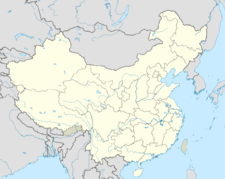Biology:Migmanychion
| Migmanychion | |
|---|---|

| |
| Life restoration | |
| Scientific classification | |
| Domain: | Eukaryota |
| Kingdom: | Animalia |
| Phylum: | Chordata |
| Clade: | Dinosauria |
| Clade: | Saurischia |
| Clade: | Theropoda |
| Clade: | Maniraptora |
| Genus: | †Migmanychion Wang et al., 2023 |
| Species: | †M. laiyang
|
| Binomial name | |
| †Migmanychion laiyang Wang et al., 2023
| |
Migmanychion (meaning "claw mixture") is an extinct genus of maniraptoran theropod dinosaur from the Early Cretaceous Longjiang Formation of China. The genus contains a single species, M. laiyang, known from an incomplete left forelimb.[1]
Discovery and naming
The Migmanychion holotype specimen, LY 2022JZ3001, was discovered in sediments of the Longjiang Formation (Pigeon Hill locality), near Baoshan in Morin Dawa Daur Autonomous Banner, Inner Mongolia, China. The specimen consists of rib fragments and a partial left arm with a complete hand, preserved on a slab and counterslab.[1]
In 2023, Wang et al. described Migmanychion laiyang as a new genus and species of maniraptoran theropod based on these fossil remains. The generic name, "Migmanychion", combines the Greek words "μείγμα νυχιών", meaning "claw mixture", referencing the difference in the morphology of the manual unguals. The specific name, "laiyang", references the holotype's home at the Shandong Laiyang Cretaceous National Geological Park.[1]
Additional fossil material found at the type locality, including an articulated pelvis and partial hindlimb, represents an individual similar in size to Migmanychion, but was not referred as it could not be proven to represent the same animal.[1]
Classification
Migmanychion is a maniraptoran theropod, but its precise placement within the clade is unclear. Wang et al. (2023) noted several similarities between Migmanychion and Fukuivenator, a premise supported by their phylogenetic analyses. However, other positions within the Oviraptorosauria and Paraves were recovered. They note that the description of additional fossil material would allow for a more confident placement. A cladogram adapted from the analysis is shown below:[1]
Paleoenvironment
Migmanychion was a member of the "Moqi Fauna" in the Longjiang Formation. It coexisted with other dinosaurs including the dromaeosaurid Daurlong,[2] indeterminate paravians,[1] and the avialans Beiguornis (an enantiornithean)[3] and Khinganornis (an ornithuromorph),[4] as well as fish and amphibians.[5]
References
- ↑ 1.0 1.1 1.2 1.3 1.4 1.5 Wang, Xuri; Cau, Andrea; Wang, Zhengdong; Yu, Kaifeng; Wu, Wenhao; Wang, Yang; Liu, Yichuan (2023-06-05). "A new theropod dinosaur from the Lower Cretaceous Longjiang Formation of Inner Mongolia (China)" (in en). Cretaceous Research 151: 105605. doi:10.1016/j.cretres.2023.105605. ISSN 0195-6671.
- ↑ Wang, Xuri; Cau, Andrea; Guo, Bin; Ma, Feimin; Qing, Gele; Liu, Yichuan (2022-11-19). "Intestinal preservation in a birdlike dinosaur supports conservatism in digestive canal evolution among theropods" (in en). Scientific Reports 12 (1): 19965. doi:10.1038/s41598-022-24602-x. ISSN 2045-2322. PMID 36402874. Bibcode: 2022NatSR..1219965W.
- ↑ "The first enantiornithine bird from the Lower Cretaceous Longjiang Formation in the Great Khingan Range of Inner Mongolia". Acta Geologica Sinica. 2022. https://global.cnki.net/kcms/detail/11.1951.P.20220118.1756.006.html.
- ↑ Wang, Xuri; Cau, Andrea; Kundrát, Martin; Chiappe, Luis M.; Ji, Qiang; Wang, Yang; Li, Tao; Wu, Wenhao (2020-02-28). "A new advanced ornithuromorph bird from Inner Mongolia documents the northernmost geographic distribution of the Jehol paleornithofauna in China". Historical Biology 33 (9): 1705–1717. doi:10.1080/08912963.2020.1731805. ISSN 0891-2963. https://doi.org/10.1080/08912963.2020.1731805.
- ↑ Yu, Zhiqiang; Dong, Liping; Huyskens, Magdalena H.; Yin, Qing-Zhu; Wang, Yuan; Deng, Chenglong; He, Huaiyu (2022-03-01). "The exceptionally preserved Early Cretaceous "Moqi Fauna" from eastern Inner Mongolia, China, and its age relationship with the Jehol Biota" (in en). Palaeogeography, Palaeoclimatology, Palaeoecology 589: 110824. doi:10.1016/j.palaeo.2021.110824. Bibcode: 2022PPP...589k0824Y. https://www.sciencedirect.com/science/article/pii/S003101822100609X.
Wikidata ☰ Q119111222 entry
 |


